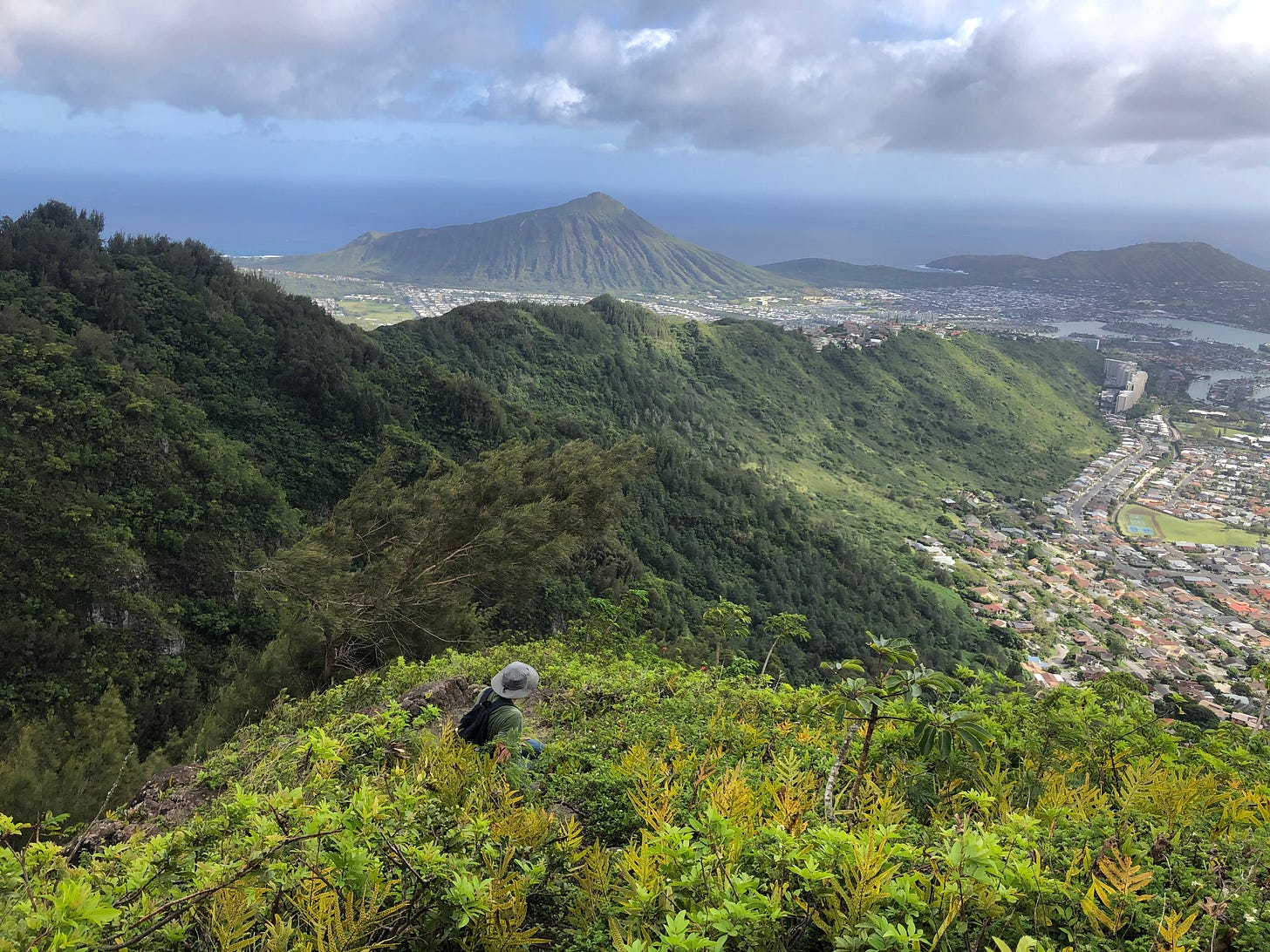Fieldnotes: What is ecocentrism?
And also: whale clicks, wolves, and how breathing connects us to the natural world.

Going for a hike in the Ko‘olau Range on O‘ahu.
What I’m reading
The Ecocentrists: A History of Radical Environmentalism, by Keith Makoto Woodhouse (2018). I’ve been delving deeper into the complex and problematic history of environmentalism in the U.S., and Woodhouse’s book recently fell into my hands.
What is ecocentrism? Woodhouse describes it this way:
“Ecocentric thought assumed that trees, bears, fish, and grasshoppers should receive as much consideration as humans in decisions large and small about the shape of modern society. An ecocentric outlook granted no more value to people—at least in terms of a basic hierarchy of existence—than it did to plants, animals, and ecosystems.
and eocentrists
“believed, fundamentally, that as modern human society gradually destroyed wild nature it veered toward catastrophe, and that its self-destruction would take much of the planet with it.”
Ecocentrists were angry. And they were impatient and skeptical of slow-moving laws and regulations to confront the environmental crisis. Direct action was the tactic of choice for ecocentrists.
For example, Woodhouse writes that the ecocentrists
“…considered the existence of natural places defined by human absence to be the best measure of planetary health. Potential wilderness disappeared every day as logging companies felled trees, governments built roads, and cities sprawled into suburbs, exurbs, and beyond.”

To stop the logging in forests around the country, and in particular the West Coast states of Washington, Oregon, and California, ecocentrists chained themselves to trees, blocked bulldozers, lived in tree-tops to prevent loggers from cutting them down, and even embedded ‘tree spikes’ to break loggers’ chainsaws. In the 1970s and 80s, for many mainstream conservation organizations like Sierra Club, ecocentrists’ direct action tactics were viewed as extreme and counter-productive in garnering broader public support for the environmental movement.
Today, Woodhouse says that the radical tradition of ecocentrism has steadily melded with more mainstream approaches to conservation, like E.O. Wilson’s ‘Half Earth’ project. But darker and more pessimistic elements of the radical ecocentrist view still exert a powerful appeal for some in the environmental movement (Look no further than Michael Moore’s new film, Planet of the Humans, which I reviewed on Medium recently).
I’m not too far into the book yet, but so far, The Ecocentrists gives us a fascinating history about a pissed off and complicated group of environmental activists in the 60s, 70s and 80s whose activism was fueled by a darker view of humans and our place in the world.
What I’m watching
“The Click Effect” Created by Sandy Soloman and James Nestor. The short 7:16 film dives into a fascinating scientific project to finally decipher the communication system of dolphins and sperm whales. It’s made for an immersive Virtual Reality experience so break out you VR glasses if you got ‘em.

What I’m listening to
The Wolf Ranger, a new episode from Chris Morgan’s The Wild podcast. I’ve been thinking quite a bit about wolf conservation since reading American Wolf: A True Story of Survival and Obsession in the West, by Nate Blakeslee. In this podcast, we learn about the work of Daniel Curry, who, in an effort to protect wolves in Washington State, protects cattle from wolves, in order to protect the wolves from ranchers: “Daniel’s new job is to literally stand between cattle and wolves.
Here’s a short video of Daniel talking about his work protecting wolves, and the underlying environmental philosophy that guides his conservation activism.

Eco-tool I’m using
Pranayama: Alternate Nasal Breathing
I’ve been thinking quite a bit about breathing lately, especially after reading James Nestor’s ‘Breath: The New Science of a Lost Art’ that I wrote about last week. I also delved into some of my thoughts on the book in a review I wrote on Medium today. Nestor describes how breathing is like a communication link between us and the environment. He writes,
“To breathe is to absorb ourselves in what surrounds us, to take in little bits of life, understand them, and give pieces of ourselves back out. Respiration is, at its core, reciprocation.”
In the book, Nestor provides a fantastic how-to guide for a variety of breathing techniques. For me, a helpful and easy breathing technique Nestor teaches at the end of the book is the alternate nasal breathing. This is a great technique before going to sleep, or to relax before embarking on your environmental activism for the day!
Put your right thumb (softly) over your right nostril, and place your right ring finger over the left nostril (don’t plug them yet). You can rest your index finger and middle finger between your eyebrows.
Now, close your right nostril with your thumb, then, very slowly, inhale through your left nostril.
Once you reach your full breath, hold both nostrils closed and pause for a moment.
Then lift your right thumb so you can exhale through the right nostril.
When you’re at the end of your exhale, hold both nostrils closed for a moment, then inhale through the right nostril.Continue like this, alternating breaths through the right, then left, then right nostrils for 5–10 cycles.
For more breathing techniques, I gathered some free resources on my post about Nestor’s book here.
Quote I’m pondering
“The breathing, sensing body draws its sustenance and its very substance from the soils, plants, and elements that surround it; it continually contributes itself, in turn, to the air, to the composting earth, to the nourishment of insects and oak trees and squirrels, ceaselessly spreading out of itself as well as breathing the world into itself, so that it is very difficult to discern, at any moment, precisely where this living body begins and where it ends.”
–David Abram, The Spell of the Sensuous
Hope you enjoyed this newsletter! See you Sunday!

